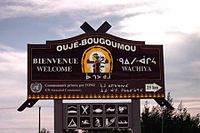
Back Kreeg ar c'hompezennoù Breton Nēhiyawēwin CR Idioma cree de las llanuras Spanish Plains cree jezik Croatian Lingua cree delle pianure Italian Prærie-cree NN Lenga cree, plains PMS Западный кри Russian Ova Kricesi Turkish
| Plains Cree | |
|---|---|
| ᓀᐦᐃᔭᐍᐏᐣ nēhiyawēwin | |
 The entrance to Quebec's Oujé-Bougoumou village writes "Welcome" in English, French, and Cree. | |
| Native to | Canada, United States |
| Region | Manitoba, Saskatchewan, Alberta, Montana |
Native speakers | 3,200 (2001–2016)[1] |
Algic
| |
| Official status | |
Official language in | Northwest Territories (Canada), as "Cree"[3] |
| Language codes | |
| ISO 639-3 | crk |
| Glottolog | plai1258 |
| ELP | Nēhiyawēwin |
| Linguasphere | 62-ADA-aa |
 Plains Cree is classified as Vulnerable by the UNESCO Atlas of the World's Languages in Danger | |

Plains Cree (endonym: ᓀᐦᐃᔭᐍᐏᐣ nēhiyawēwin; alternatively: ᐸᐢᑳᐧᐃᐧᓃᒧᐃᐧᐣ paskwâwinîmowin "language of the prairie people"[5]) is a dialect of the Algonquian language, Cree, which is the most populous Canadian indigenous language. Plains Cree is considered a dialect of the Cree-Montagnais language or a dialect of the Cree language that is distinct from the Montagnais language. Plains Cree is one of five main dialects of Cree in this second sense, along with Woods Cree, Swampy Cree, Moose Cree, and Atikamekw. Although no single dialect of Cree is favored over another, Plains Cree is the one that is the most widely used. Out of the 116,500 speakers of the Cree language, the Plains Cree dialect is spoken by about 34,000 people primarily in Saskatchewan and Alberta but also in Manitoba and Montana.
The number of people who can speak an Aboriginal language, such as Plains Cree, has increased. For example, in the 2016 census, 263,840 people could speak an Aboriginal language well enough to conduct a conversation. From 1996 to 2016, the total number of people who were able to speak an Aboriginal language went up by 8%. The number of Plains Cree speakers similarly has increased along with population increases over the past 20 years.[6]
- ^ Plains Cree at Ethnologue (25th ed., 2022)

- ^ Hammarström, Harald; Forkel, Robert; Haspelmath, Martin; Bank, Sebastian (24 May 2022). "Cree-Montagnais-Naskapi". Glottolog. Max Planck Institute for Evolutionary Anthropology. Archived from the original on 15 October 2022. Retrieved 29 October 2022.
- ^ "Official Languages of the Northwest Territories" (PDF). Archived from the original (PDF) on 6 December 2013.
- ^ Cite error: The named reference
esaskwas invoked but never defined (see the help page). - ^ "Plains Cree language". Plains Cree Dictionary. Algonquin Dictionary Projects. Retrieved 7 November 2023.
- ^ *Stats Canada
© MMXXIII Rich X Search. We shall prevail. All rights reserved. Rich X Search